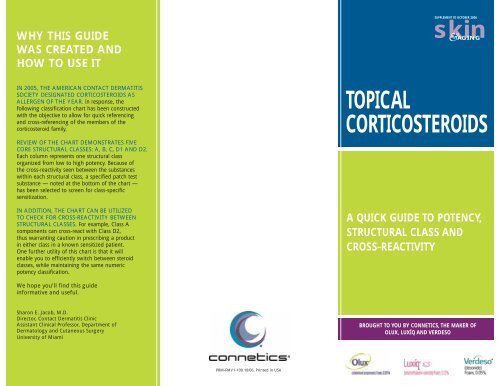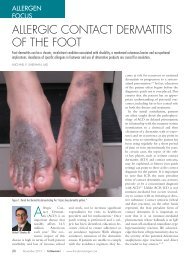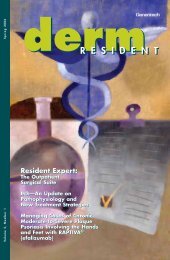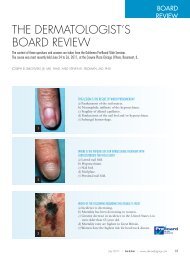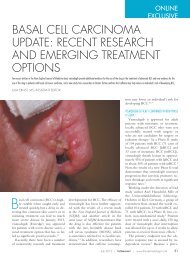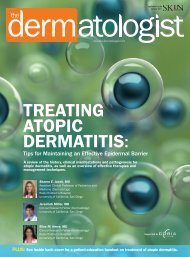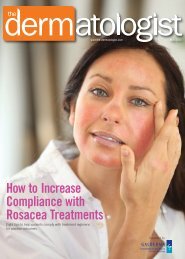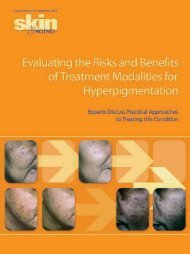TOPICAL CORTICOSTEROIDS - The Dermatologist
TOPICAL CORTICOSTEROIDS - The Dermatologist
TOPICAL CORTICOSTEROIDS - The Dermatologist
You also want an ePaper? Increase the reach of your titles
YUMPU automatically turns print PDFs into web optimized ePapers that Google loves.
WHY THIS GUIDEWAS CREATED ANDHOW TO USE ITIN 2005, THE AMERICAN CONTACT DERMATITISSOCIETY DESIGNATED <strong>CORTICOSTEROIDS</strong> ASALLERGEN OF THE YEAR. In response, thefollowing classification chart has been constructedwith the objective to allow for quick referencingand cross-referencing of the members of thecorticosteroid family.REVIEW OF THE CHART DEMONSTRATES FIVECORE STRUCTURAL CLASSES: A, B, C, D1 AND D2.Each column represents one structural classorganized from low to high potency. Because ofthe cross-reactivity seen between the substanceswithin each structural class, a specified patch testsubstance — noted at the bottom of the chart —has been selected to screen for class-specificsensitization.IN ADDITION, THE CHART CAN BE UTILIZEDTO CHECK FOR CROSS-REACTIVITY BETWEENSTRUCTURAL CLASSES. For example, Class Acomponents can cross-react with Class D2,thus warranting caution in prescribing a productin either class in a known sensitized patient.One further utility of this chart is that it willenable you to efficiently switch between steroidclasses, while maintaining the same numericpotency classification.SUPPLEMENT TO OCTOBER 2006skin&AGING<strong>TOPICAL</strong><strong>CORTICOSTEROIDS</strong>A QUICK GUIDE TO POTENCY,STRUCTURAL CLASS ANDCROSS-REACTIVITYWe hope you’ll find this guideinformative and useful.Sharon E. Jacob, M.D.Director, Contact Dermatitis ClinicAssistant Clinical Professor, Department ofDermatology and Cutaneous SurgeryUniversity of MiamiBROUGHT TO YOU BY CONNETICS, THE MAKER OFOLUX, LUXÍQ AND VERDESOPRM-FMV1-100 10/06. Printed in USA
Structural Class Class A: Class B: Class C: Class D1: Class D2:Hydrocortisone Type Triamcinolone Acetonide Type Betamethasone Type Betamethasone Dipropionate Type Methylprednisolone Aceponate TypeCLASS 7: LEAST POTENTHydrocortisoneHydrocortisone acetateMethylprednisolone,prednisoloneTixocortol pivalateCLASS 6: LOW POTENTDesonide 0.05% C, FFluocinolone acetonide 0.01% C, STriamcinolone acetonide 0.025% CTriamcinolone diacetate 0.025% CAlclometasone dipropionate 0.05% C, OBetamethasone valerate 0.1% CCLASS 5: LOWER MID-STRENGTHCLASS 4: MID-STRENGTHCLASS 3: UPPER MID-STRENGTHCLASS 2: HIGH POTENTCLASS 1: SUPERPOTENTADDITIONAL INFORMATIONSTRUCTURECROSS-REACTIONSPATCH TEST SUBSTANCEOral: CloprednolFludrocortisone acetateMethylprednisolone,prednisoloneNo substitutions in theD ring, except C21 –short-chain estersCross-reacts with D2Tixocortol-21-pivalateDesonide 0.05% OFluocinolone acetonide 0.025% CTriamcinolone acetonide0.1% C, 0.025% O, LTriamcinolone diacetate 0.1% CAmcinonide 0.1% CFluocinolone acetonide 0.01%, 0.025% OHalcinonide 0.025% CTriamcinolone acetonide 0.1% OTriamcinolone diacetate 0.1% OAmcinonide 0.1% LFluocinonide 0.05%Triamcinolone acetonide 0.1% C, OTriamcinolone diacetate 0.1% C, OAmcinonide 0.1% O, L, CBudesonide 0.025% CFluocinonide 0.05% C, O, G, SHalcinonide 0.1% C, O, SOral: BudesonideTriamcinoloneC16,17 – cis-diol or – ketalBudesonide specificallycross-reacts with D2BudesonideTriamcinolone acetonideLEGEND: C=Cream, G=Gel, L=Lotion, O=Ointment, S=Solution, F=FoamReferences1. Jacob SE, Steele T. Corticosteroid classes: a quick reference. J Am Acad Dermatol. 2006;54:723-7.2. De Groot AC, Weyland JW, Nater JP. Unwanted effects of cosmetics and drugs used in dermatology. Third Ed. Amsterdam: Elsevier; 1994.3. De Groot AC. Patch testing: concentrations and vehicles for 3700 chemicals. Second Ed. New York: Elsevier; 1994. p.307.Clocortolone pivalate 0.1% CDesoximetasone 0.05% CDesoximetasone 0.25% C, 0.05% GOral: BetamethasoneDexamethasoneC16 – methyl substitutionBetamethasone dipropionate 0.05% LBetamethasone valerate C, LFluticasone propionate 0.05% CBetamethasonevalerate 0.12% FClobetasone butyrate 0.05%Mometasone furoate 0.1% C, LBetamethasone dipropionate 0.05% CBetamethasone valerate 0.1% OClobetasone butyrate 0.05%Diflorasone diacetate 0.05% CFluticasone propionate 0.005% OMometasone furoate 0.1% OBetamethasone dipropionate 0.05% O, CBetamethasone valerate 0.1%Diflorasone diacetate 0.05%Betamethasone dipropionate0.05% G, O, LClobetasol propionate0.05% C, O, G, S, FDiflorasone diacetate0.05% OOral/IM: BetamethasoneC16 – methyl substitutionC17/C21 – long-chain esterClobetasol-17-propionateHydrocortisone buteprate 0.1% C, O, SHydrocortisone butyrate 0.1% C, O, SHydrocortisone valerate 0.2% CPrednicarbate 0.1% CHydrocortisone valerate 0.2% OOral/IV: HydrocortisoneC16 – no methyl substitutionC16 – no halogenationC17 – long-chain esterC21 – possible side chainCross-reacts with Class A andbudesonideHydrocortisone-17-butyrateVerdeso is a trademark, and OLUX, Luxiq, the foam icon, the interlocking “C” logo, and Connetics are registered trademarks of Connetics Corporation.4. Scheuer E, Warshaw E. Allergy to Corticosteroids: Update and Review of Epidemiology, Clinical Characteristics, andStructural Cross Reactivity. Am J Contact Dermat 2003; 14(4):179-187.5. Sasaki. Corticosteroid sensitivity and cross-sensitivity. Contact Dermatitis. 1990;23:306-15.6. Fisher AA, editor. Reactions to topical steroids. Contact Dermatitis. Third Ed. Philadelphia: Lea and Febiger; 1986. p.203-10.Adapted from Jacob SE, Steele T. Corticosteroid classes: a quick reference guide including patch test substances and cross-reactivity. J Am Acad Dermatol. 2006;54:723-727.


